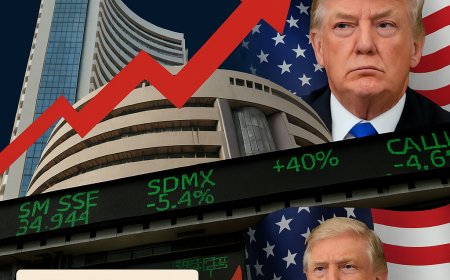Core sector growth falls to nine-month low of 0.7% in May
India's core sector growth dropped to a nine-month low of 0.7% in May 2025 due to contractions in key infrastructure industries. Read the full sectoral breakdown, analyst insights, and market outlook.

New Delhi, June 20, 2025:
India's infrastructure sector recorded a sharp slowdown in May 2025, with the core sector growing at just 0.7%, marking its lowest pace in nine months, as per data released by the Ministry of Commerce and Industry. The deceleration was largely attributed to weak performance across six of the eight core industries, raising concerns about industrial momentum and overall economic recovery.
Understanding the Core Sector
The core sector comprises eight key infrastructure industries: coal, crude oil, natural gas, refinery products, fertilizers, steel, cement, and electricity. These sectors together account for 40.27% of the Index of Industrial Production (IIP), making them a critical barometer of the country's economic health.
In May 2024, core sector output had expanded by 5.2%, highlighting the stark contrast in performance over a year.
Sector-Wise Breakdown: A Broad-Based Slowdown
According to official data, only coal and fertilizers registered positive year-on-year growth in May, while the rest of the sectors saw contractions or subdued activity:
-
Coal production rose by 10.2%, reflecting strong demand from the power sector and increased mining activity.
-
Fertilizer output edged up by 3.4%, partly supported by the early onset of monsoon-related demand.
-
Cement output fell sharply by 6.2%, a worrying sign for the construction and real estate sectors.
-
Electricity generation contracted by 1.8%, suggesting reduced industrial consumption.
-
Steel output dipped by 2.4%, hit by weaker export demand and high raw material costs.
-
Refinery products shrank by 3.1%, while natural gas and crude oil declined by 1.4% and 1.1%, respectively.
This widespread slowdown indicates an overall slack in infrastructure-related activities and a potential drag on future industrial production numbers.
Expert Take: Warning Signs Ahead
Economists view the May figures as a reflection of waning demand and base effect distortion.
"A 0.7% growth in the core sector is a red flag. The contraction in cement and steel suggests a broader industrial and construction slowdown, which may eventually pull down GDP growth in Q1 FY26," said Dr. Radhika Rao, Chief Economist at DBS Bank India.
"The core sector's performance is also a precursor to IIP numbers. So, expect some softness in the upcoming industrial output data," added Devendra Kumar, Senior Analyst, Motilal Oswal Financial Services.
Macroeconomic Context: Growth Outlook Under Scrutiny
India's economy has been navigating multiple headwinds, including global trade disruptions, volatile crude oil prices, and fluctuating inflation trends. The Q4 FY25 GDP data had shown resilience, clocking in at 6.9%, but experts had warned of challenges ahead due to tight liquidity, interest rate concerns, and tepid export demand.
The disappointing core sector growth may feed into concerns about slowing momentum in private investment and industrial production, even as the country prepares for its Union Budget 2025-26 in July.
Government's Response and Industry Expectations
Officials have acknowledged the slowdown but remain optimistic. A senior official from the Ministry of Commerce said:
“May’s numbers reflect temporary challenges. With expected monsoon normalization, capital expenditure push in the Budget, and easing commodity prices, we anticipate a rebound in coming months.”
However, industry bodies are calling for policy support and faster project clearances. The Confederation of Indian Industry (CII), in a statement, emphasized the need for infrastructure spending, expedited disbursal of public sector projects, and lowering input costs for core industries.
Investor Outlook: Market Impact and Strategic Implications
Equity markets have shown muted response to the data so far, with indices reacting more to global cues and FPI movements. However, bond markets have taken note, with 10-year yields falling slightly, suggesting expectations of a more dovish RBI stance if growth indicators continue to weaken.
Investors and fund managers are now closely watching for:
-
June and July core sector performance
-
Policy signals in the Union Budget
-
RBI’s next monetary policy meeting
“The 0.7% number, though concerning, is not enough to shift investor sentiment drastically yet. But if this trend sustains, sectors like cement, metals, and industrials could come under pressure,” said Minal Doshi, Fund Manager, HDFC Mutual Fund.
An Inflection Point?
The sharp moderation in India’s core sector growth serves as a wake-up call for policymakers and industry stakeholders. While cyclical factors and base effects may partly explain the dip, the broad-based nature of the decline points to deeper structural issues.
Whether this turns out to be a temporary dip or the beginning of a more prolonged slowdown will depend on how effectively the government addresses supply bottlenecks and boosts domestic demand. The upcoming Union Budget could play a crucial role in reviving investor and industry confidence.
What's Your Reaction?
 Like
0
Like
0
 Dislike
0
Dislike
0
 Love
0
Love
0
 Funny
0
Funny
0
 Angry
0
Angry
0
 Sad
0
Sad
0
 Wow
0
Wow
0












































































